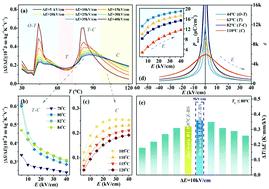当前位置:
X-MOL 学术
›
J. Mater. Chem. C
›
论文详情
Our official English website, www.x-mol.net, welcomes your feedback! (Note: you will need to create a separate account there.)
Decoding the relationship between the electrocaloric strength and phase structure in perovskite ferroelectrics towards high performance
Journal of Materials Chemistry C ( IF 6.4 ) Pub Date : 2020-11-17 , DOI: 10.1039/d0tc04531d Xiaowei Wei 1, 2, 3 , Chunlin Zhao 1, 2, 3 , Ting Zheng 1, 2, 3 , Jiagang Wu 1, 2, 3
Journal of Materials Chemistry C ( IF 6.4 ) Pub Date : 2020-11-17 , DOI: 10.1039/d0tc04531d Xiaowei Wei 1, 2, 3 , Chunlin Zhao 1, 2, 3 , Ting Zheng 1, 2, 3 , Jiagang Wu 1, 2, 3
Affiliation

|
Electrocaloric effect represents an environmentally friendly cooling alternative to replace the currently ubiquitous vapor-compression-based refrigeration. Previous studies have shown that large electrocaloric response is associated with the polarization change, which peaks around the phase transition temperature. However, there is only little focus on the effect of the detailed phase structure on the electrocaloric properties, particularly on the electrocaloric strength (ΔT/ΔE). For the first time, the correlation between ΔT/ΔE and the phase structure of perovskite ferroelectric materials was investigated, and a new frame to obtain optimized ΔT/ΔE related to the phase structure regulation was revealed. Given the simple and legible phase structure, BaTiO3-based ceramics are selected as a platform to reveal this relationship by employing both indirect and direct measurements. A striking variation of ΔT/ΔE and entropy change coefficient versus the electric field was first noticed at different phase structures: decreasing at the phase boundaries, whereas increasing in the pure phase regions, which could attribute to distinct entropy change mechanisms stemming from the discrepant energy profile at different phase structures. Beyond that, the maximum electrocaloric temperature change of ∼1 K and a large ΔT/ΔE of 0.48–0.25 × 10−6 K m V−1 were achieved under 5–40 kV cm−1. Also, a broad temperature span of 58 K with high ΔT/ΔE was maintained under 40 kV cm−1, and a desired electric field-stable ΔT/ΔE could be acquired. Our research provides a new paradigm for further designing and optimizing the electrocaloric performance of lead-free perovskite ferroelectrics.
中文翻译:

钙钛矿铁电体的电热强度与相结构之间的关系朝着高性能的方向解码
电热效应代表了一种环保的冷却替代品,以取代目前普遍使用的基于蒸汽压缩的制冷。先前的研究表明,大的电热响应与极化变化有关,极化变化在相变温度附近达到峰值。然而,仅关注于详细的相结构对电热性能,特别是电热强度(ΔT / ΔE)的影响。首次研究了ΔT / ΔE与钙钛矿铁电材料的相结构之间的相关性,并获得了获得最佳ΔT / ΔE的新框架揭示了与相结构调节有关的。鉴于简单和清晰的相结构,选择了BaTiO 3基陶瓷作为通过采用间接和直接测量来揭示这种关系的平台。首先在不同的相结构上注意到ΔT / ΔE和熵变系数相对于电场的显着变化:在相边界处减小,而在纯相区域中增加,这可能归因于源自不同相结构的能量分布不一致。除此之外,最大的电热温度变化约为1 K,ΔT / ΔE较大,为0.48–0.25×10-6 K m值V -1物在5-40千伏厘米实现-1。另外,将ΔT / ΔE高的58K的宽温度范围维持在40kVcm -1以下,可以获得期望的电场稳定的ΔT / ΔE。我们的研究为进一步设计和优化无铅钙钛矿铁电体的电热性能提供了新的范例。
更新日期:2021-01-19
中文翻译:

钙钛矿铁电体的电热强度与相结构之间的关系朝着高性能的方向解码
电热效应代表了一种环保的冷却替代品,以取代目前普遍使用的基于蒸汽压缩的制冷。先前的研究表明,大的电热响应与极化变化有关,极化变化在相变温度附近达到峰值。然而,仅关注于详细的相结构对电热性能,特别是电热强度(ΔT / ΔE)的影响。首次研究了ΔT / ΔE与钙钛矿铁电材料的相结构之间的相关性,并获得了获得最佳ΔT / ΔE的新框架揭示了与相结构调节有关的。鉴于简单和清晰的相结构,选择了BaTiO 3基陶瓷作为通过采用间接和直接测量来揭示这种关系的平台。首先在不同的相结构上注意到ΔT / ΔE和熵变系数相对于电场的显着变化:在相边界处减小,而在纯相区域中增加,这可能归因于源自不同相结构的能量分布不一致。除此之外,最大的电热温度变化约为1 K,ΔT / ΔE较大,为0.48–0.25×10-6 K m值V -1物在5-40千伏厘米实现-1。另外,将ΔT / ΔE高的58K的宽温度范围维持在40kVcm -1以下,可以获得期望的电场稳定的ΔT / ΔE。我们的研究为进一步设计和优化无铅钙钛矿铁电体的电热性能提供了新的范例。



























 京公网安备 11010802027423号
京公网安备 11010802027423号